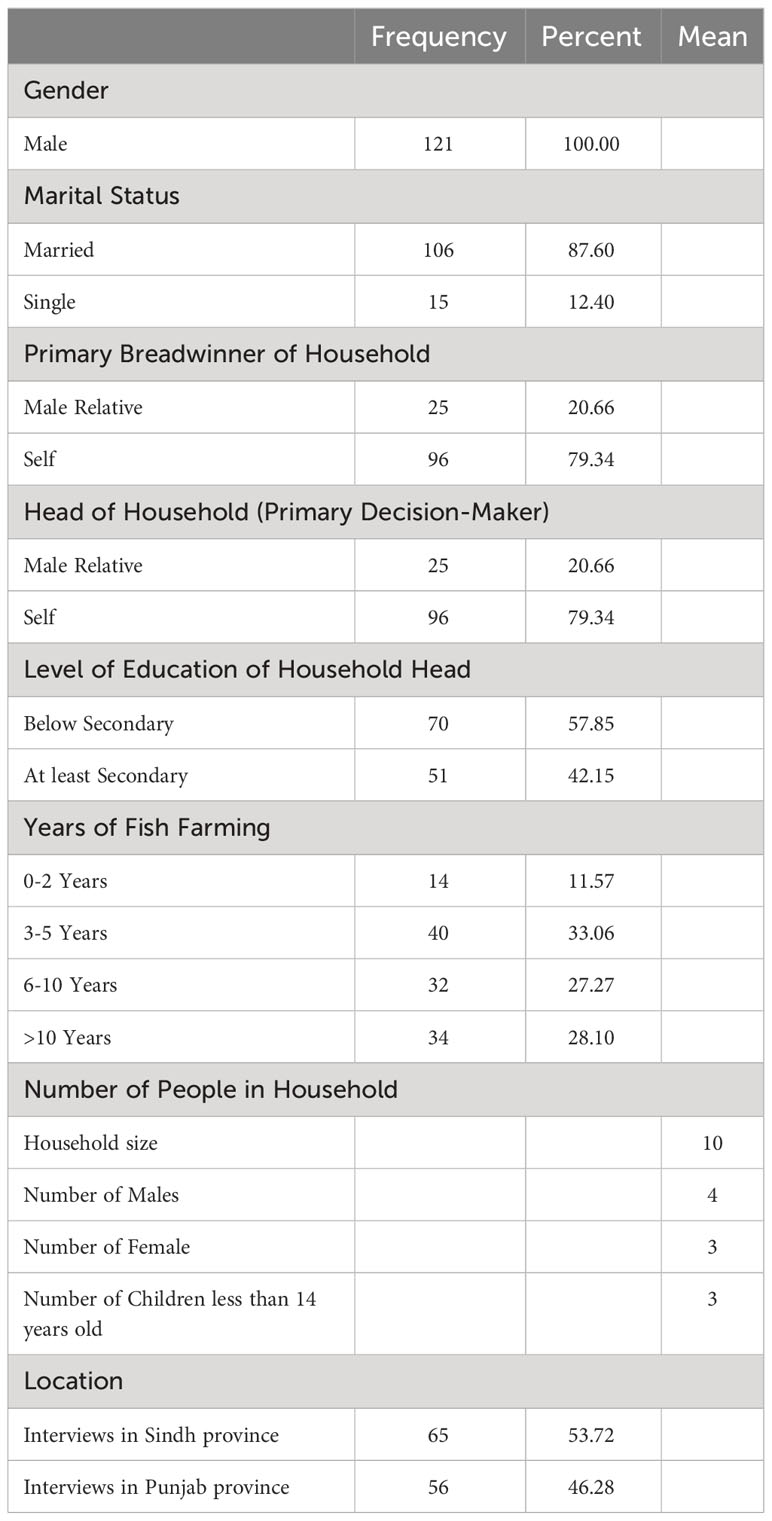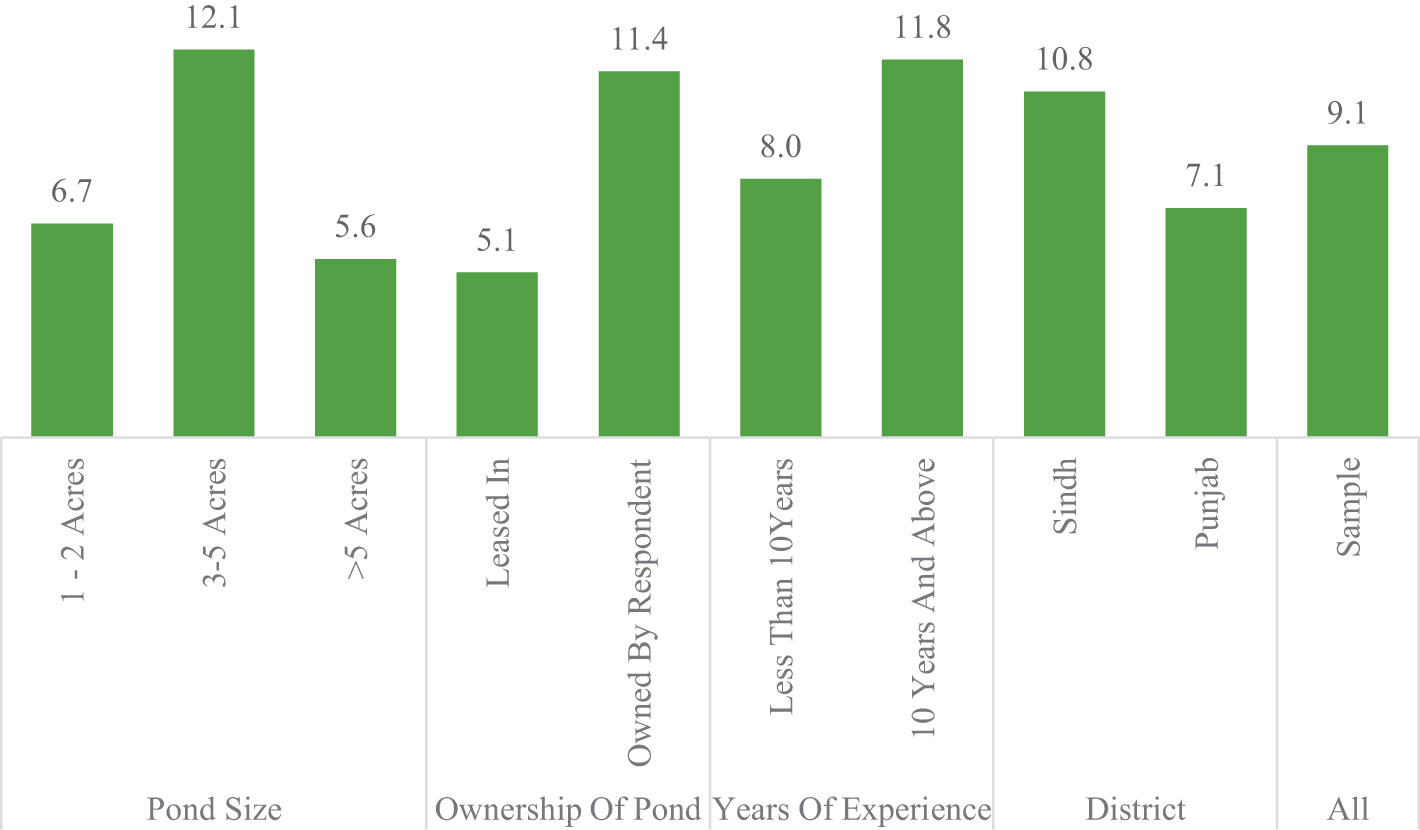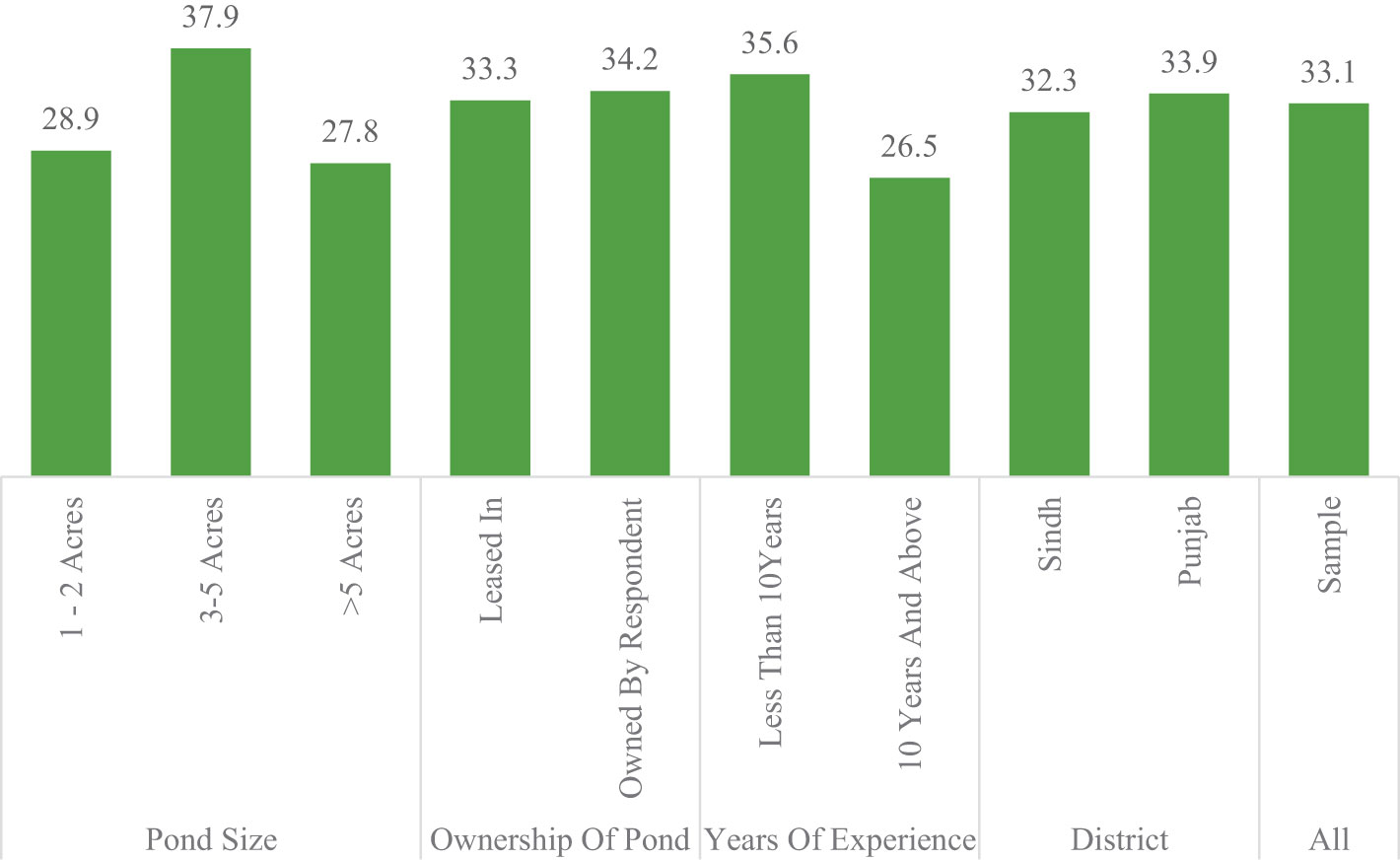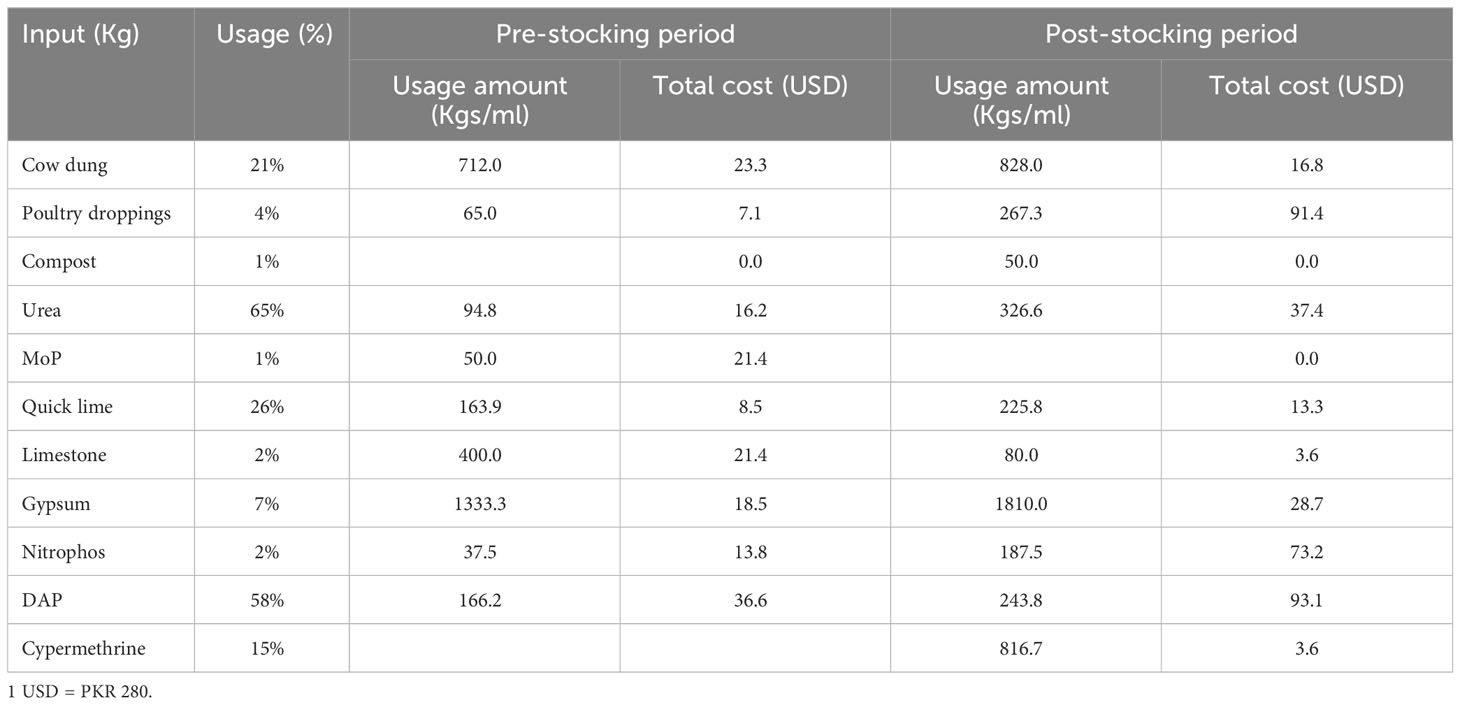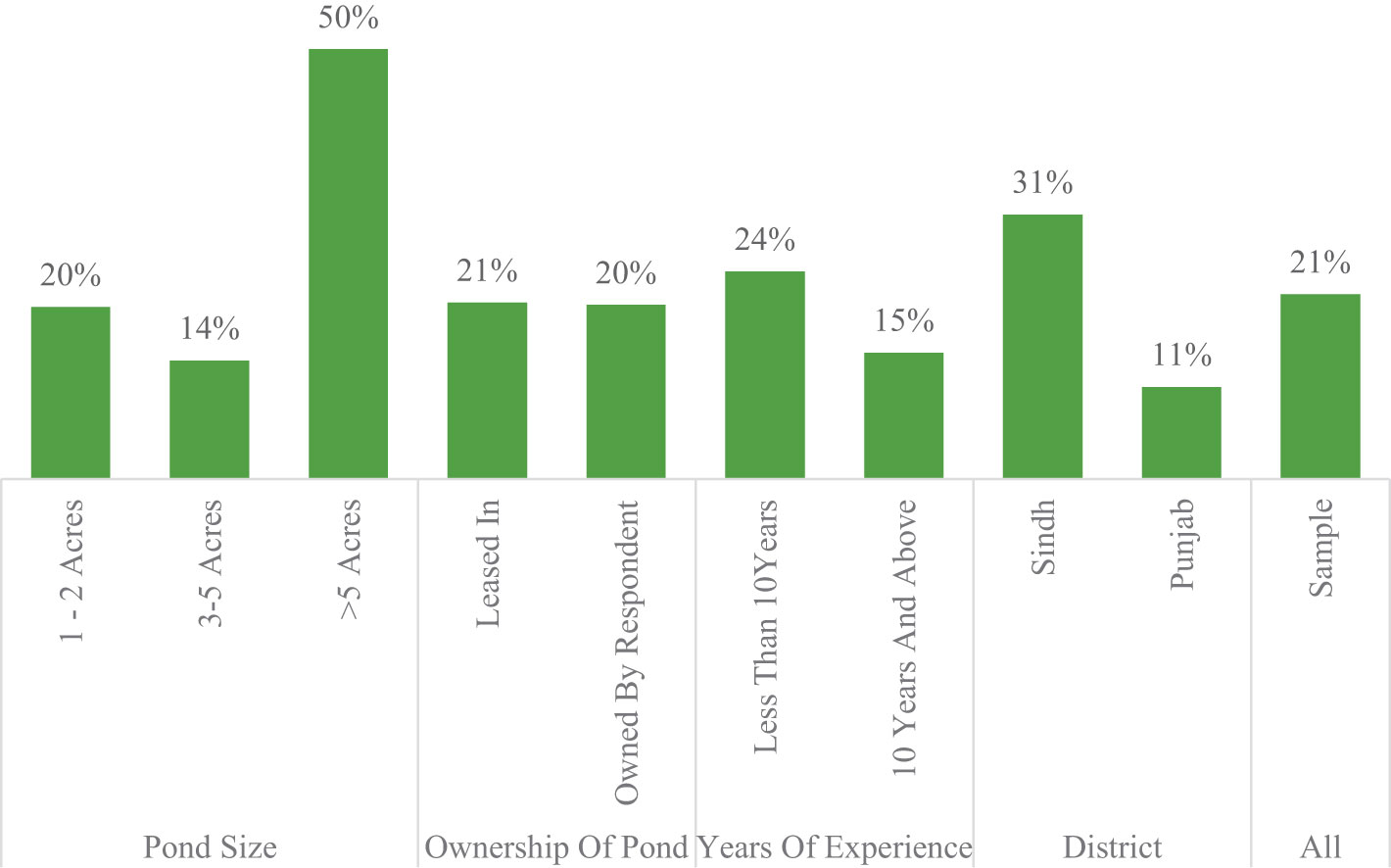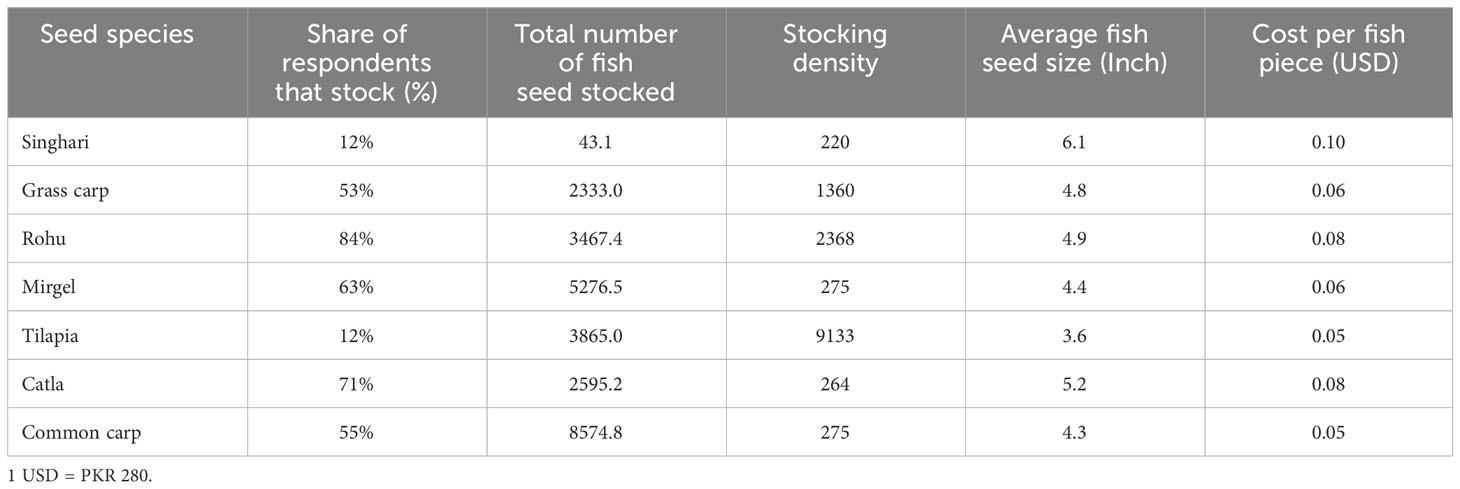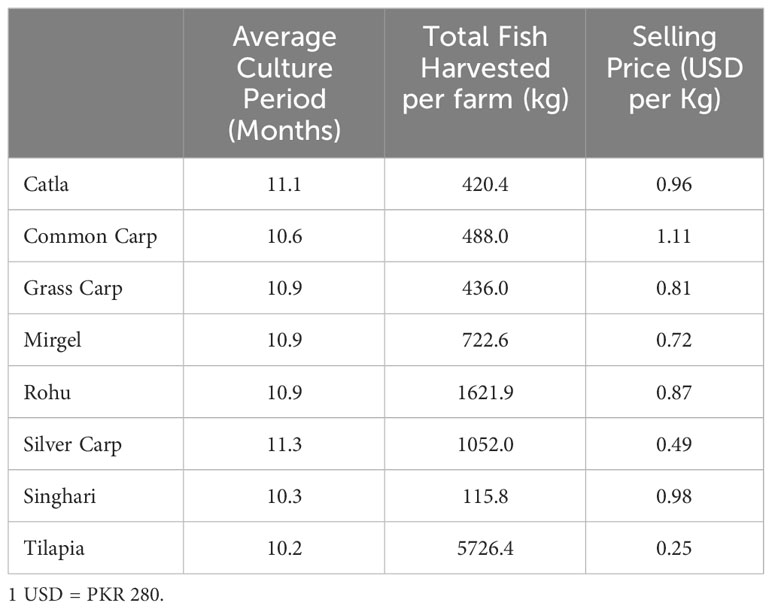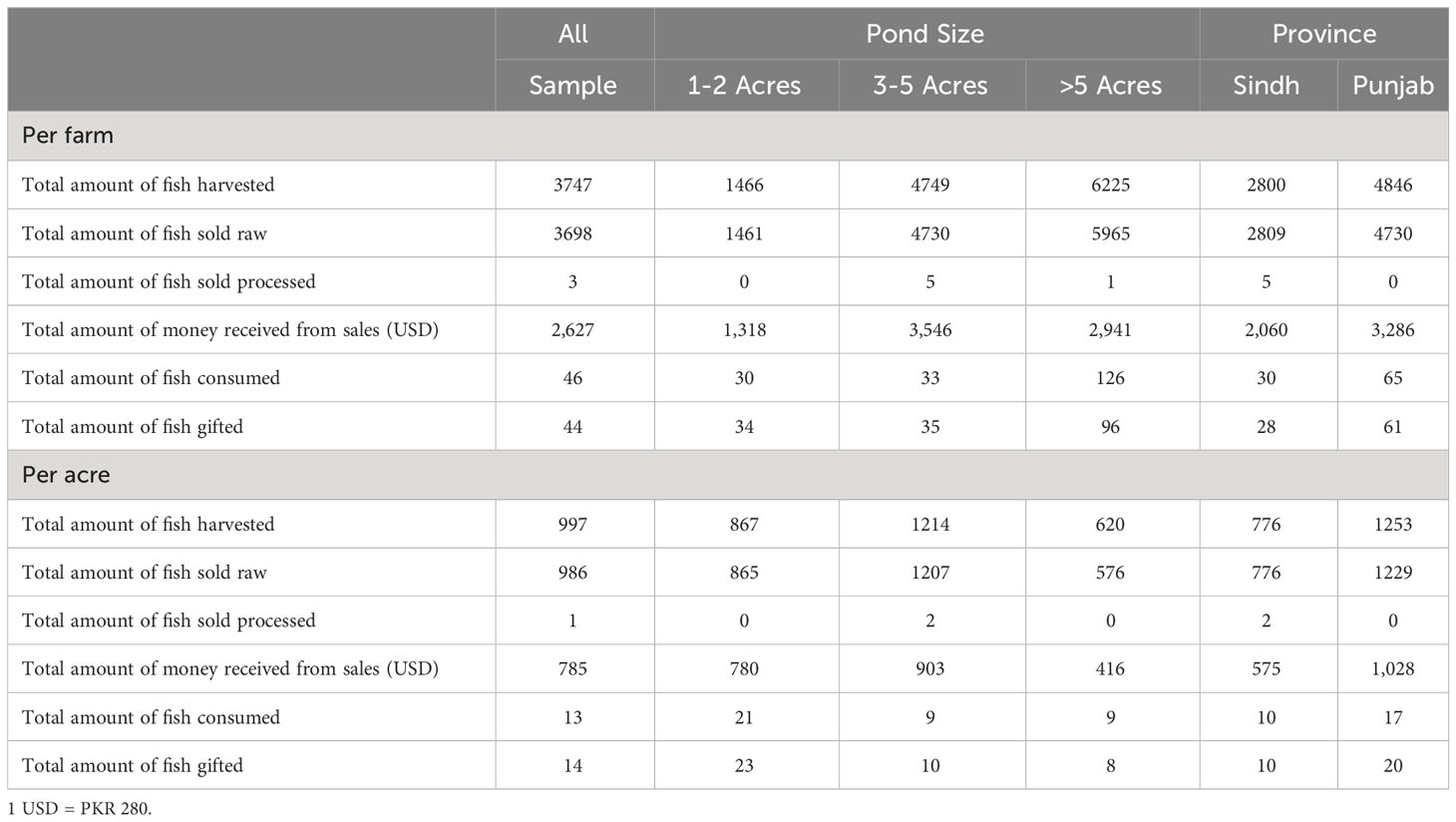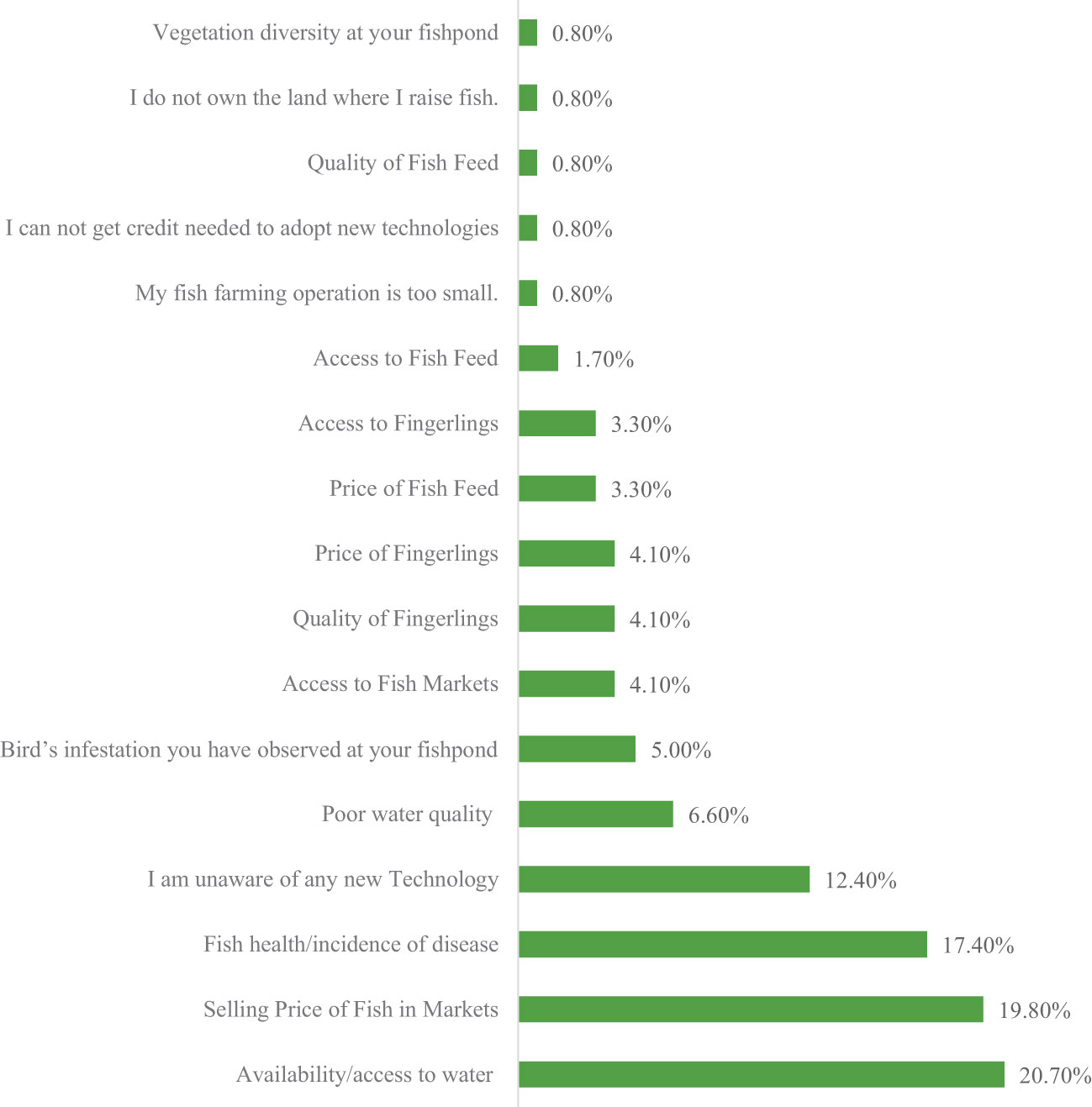Production system and challenges of saline aquaculture in Punjab and Sindh provinces of Pakistan
- 1WorldFish, Penang, Malaysia
- 2Institute for Future Initiatives, University of Tokyo, Bunkyo, Japan
- 3International Water Management Institute, Lahore, Pakistan
Introduction: Lack of data about saline aquaculture in Pakistan has curtailed informed policy and investment decision making resulting in undervaluation of and underinvestment in the sector. Therefore, saline aquaculture in Pakistan is today an underdeveloped sector despite its potential as an alternative livelihood for the country's rural farmers. This study represents one of the initial exploratory investigations into saline aquaculture systems in Pakistan, aiming to comprehend the existing sectoral landscape, production challenges, post-harvest constraints, and the associated capacity and investment needs.
Methods: The study employed purposive sampling to survey 121 low-income saline aquaculture farmers across five districts of Southern Punjab and Sindh provinces. The analysis was carried out using descriptive statistics.
Results: The results revealed that the saline aquaculture sector is predominantly male-centric, with agricultural land utilized for both agriculture and aquaculture purposes. Ponds, which usually serve multiple functions, focus primarily on carp production, but adherence to good management practices remains limited. Farmers face various challenges, including the high costs of feed and seeds, freshwater scarcity, inadequate technical knowledge, and marketing issues.
Discussion and conclusion: This study serves as a foundational assessment, addressing data and information gaps crucial for supporting the sustainable development of saline aquaculture in Pakistan. To facilitate such development, the study recommends initiating programs to strengthen technical skills in saline aquaculture, together with the establishment of hatcheries and breeding stations for saline-tolerant species, aiming to reduce dependence on freshwater species in saline pond environments.
1 Introduction
Rising salinity in Pakistan has created a difficult challenge for agricultural activities, necessitating alternative livelihoods for rural farmers. Climate change, coupled with floods and escalating salinity levels, has become a primary driver of livelihood loss for thousands of farmers in rural areas. The arid and semi-arid climate, characterized by scarce and irregular rainfall, exacerbates salinity and waterlogging, rendering vast acres unsuitable for cultivation and intensifying rural poverty and food insecurity (World Bank, 2021).
Amid these multifaceted challenges, a recent development has emerged: saline aquaculture, a land-based aquaculture utilizing saline groundwater on lands deemed unfit for crop cultivation, has emerged as a viable alternative for rural farming households. This shift is particularly pronounced in areas with brackish groundwater, such as Sindh and Punjab provinces. Saline aquaculture, at its core, involves the cultivation of aquatic organisms in waters with elevated salinity levels. In the context of Punjab and Sindh provinces, this often takes the form of land-based ponds utilizing saline groundwater. The ponds are strategically located, considering their proximity to seashores in coastal areas or constructed in the hinterland using irrigated waters connected to the sea. This unique approach allows for the utilization of lands rendered unsuitable for traditional crop cultivation due to salinity and waterlogging.
However, despite the potential of saline aquaculture, Pakistan’s aquaculture sector remains underdeveloped and in need of strategic development (Patil et al., 2018). As of 2021, fisheries contributed merely 0.4% to the country’s GDP, with approximately 390,000 people employed directly in fisheries and aquaculture. In contrast to neighboring countries like Bangladesh and India, aquaculture production in Pakistan lags behind, with slow growth rates of around 1.5% per year, compared to India’s 8% and Bangladesh’s 2.3% (FAO, 2022a). Figure 1 illustrates the significant disparities in aquaculture production among Pakistan, Bangladesh, and India.
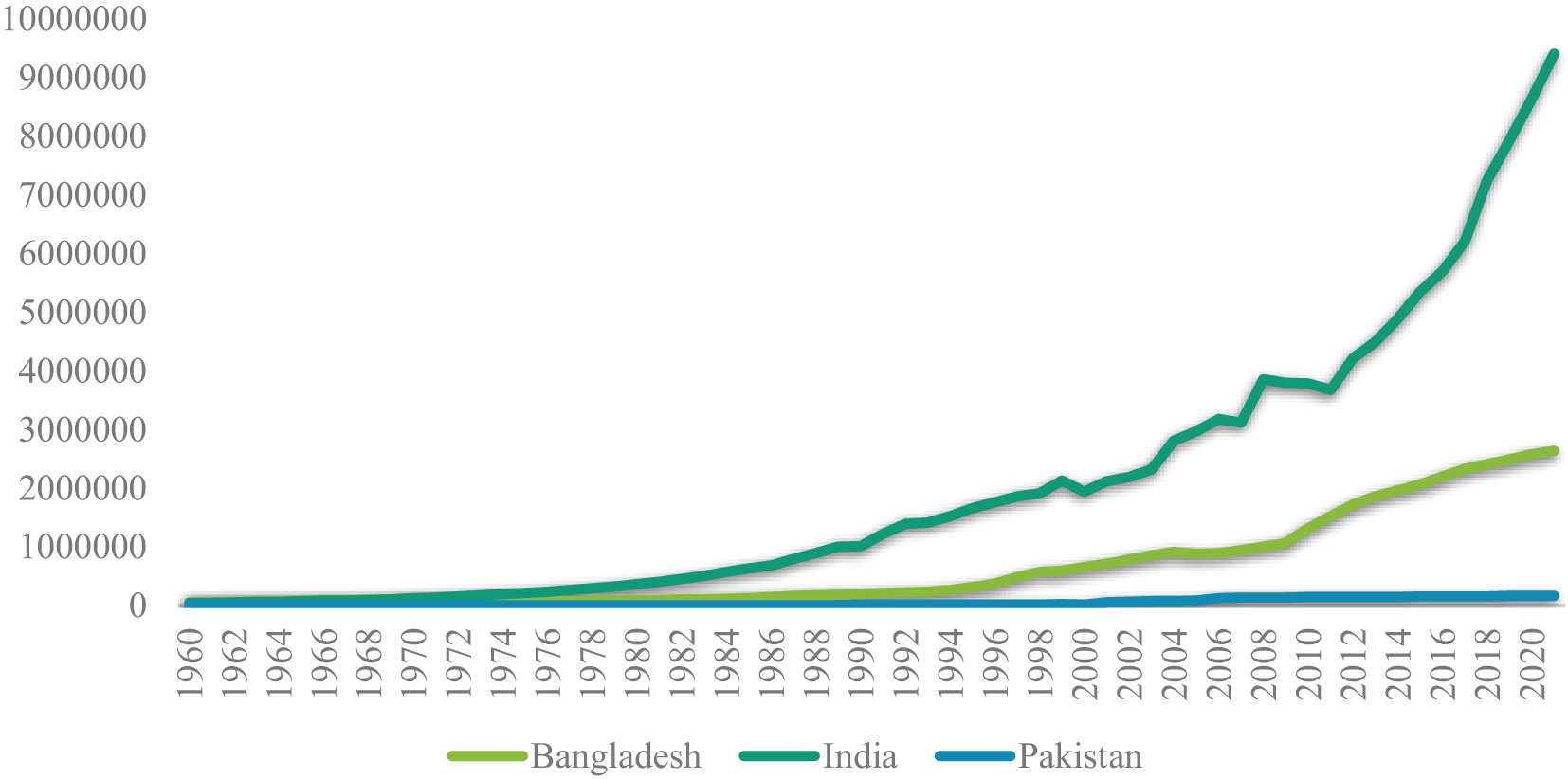
Figure 1 Aquaculture Production (metric tons) – Pakistan, Bangladesh and India. Source: FAOSTAT, 2023.
While saline aquaculture is rapidly evolving globally, featuring prominently in countries like Israel, the USA, India, Bangladesh, and Australia with substantial government investments (Allan et al., 2009; Anufriieva, 2018; Faruque et al., 2017; Mandal et al., 2021), it remains a nascent practice in Pakistan, with limited support for farmers. Studies from India and Bangladesh highlight the positive impact of saline aquaculture on nutrition, income, employment generation, and women’s empowerment in coastal regions (Belton et al., 2017; Hernandez et al., 2018; Kumar & Sharma, 2020; Mamun et al., 2021; Dam Lam et al., 2022). However, there is currently no such study or data for Pakistan. Thus, the lack of information on the saline aquaculture sector in Pakistan impedes the development of effective policies and strategies.
This study represents one of the initial exploratory investigations conducted on saline aquaculture systems in Pakistan, specifically focusing on Sindh and Punjab provinces. By delving into the current sectoral landscape, production challenges, post-harvest constraints, and capacity and investment needs, this study aims to bridge the knowledge gap and inform crucial policy decisions for the growth of saline aquaculture in the country.
2 Materials and methods
2.1 Study area
This investigation stems from an exploratory survey conducted in 2022 by the International Water Management Institute (IWMI) and WorldFish, focusing on the landscape of saline aquaculture in Pakistan. The survey specifically targeted Southern Punjab and Sindh Provinces, where soil salinity poses a growing challenge in the agriculture sector.
According to FAO estimates (FAO 2022b), aquaculture covers 121 thousand acres in Sindh and 27 thousand acres in Punjab, featuring fish farms averaging between 12 to 25 acres. Previous research indicates that in Punjab, 23% of the area contends with poor groundwater quality, while in Sindh, a substantial 78% of the groundwater is saline due to the confinement of fresh groundwater to a narrow strip along the river Indus (Qureshi, 2020). Annually, about 100 thousand acres are abandoned within the Indus Basin due to secondary salinization (Qureshi et al., 2008), rendering these areas unsuitable for traditional irrigation or field crop production.
Recognizing the potential of saline areas in Punjab and Sindh for aquaculture, provincial fisheries departments introduced fish farming techniques in earthen ponds and community reservoirs as early as the 1960s. Patil et al. (2018) highlighted the introduction of polycultures involving Indian and Chinese carps in the two provinces since the 1980s. Recent trends reveal an increasing adoption of commercially produced fish feed, including floating and sinking pellets, by fish farmers.
Punjab and Sindh were chosen for this study due to their significant potential for enhancing farmers livelihood through saline aquaculture. Moreover, these areas exhibit scalability potential across diverse regions if proven successful (Troell et al., 2009). In districts such as Thatta, Badin, and Dadu in Sindh, fish farming commonly occurs in waterlogged floodplains, with major species like carp and tilapia (Patil et al., 2018). Meanwhile, aquaculture species in districts like Sheikhpura, Gujranwala, Attock, and Muzarfagarh in Punjab include carp, tilapia, trout, shrimp, and catfish. Punjab also boasts several feed producers and fish training centers, such as the Punjab Fisheries Research and Training Centre.
2.2 The survey
The research incorporated on-site visits, surveys targeting saline aquaculture farmers, and extensive consultations with stakeholders. District selection involved consultations with stakeholders in Sindh and Punjab, identifying marginalized saline areas with potential for aquaculture improvement. The chosen districts were in South Punjab (Dera Ghazi Khan and Rahim Yar Khan) and in Sindh (Thatta and Badin). To know the universe of saline ponds population, a spatial analysis was conducted using high resolution imagery to mark ponds in the study area. At the second step, a random sampling approach was used to reach out the sample size by using the basis which produced statistically significant results and keep the cost of primary data collection within the available budget. The basis used for sample size calculation were population size of 4560 ponds, 95% confidence level and 10% margin of error.
The team collaborated with the Pakistan Council of Research on Water Resources (PCRWR) and local partners and universities in identifying eligible farmers. At the end, 121 farmers across five districts in Sindh and Punjab: Bahawalpur (n=5), Thatta (n=35), Badin (n=30), DGK/Muzaffargarh (n=30), and Rahim Yar Khan (n=21) were selected through snowball approach1. The selection criteria focused on low-income farmers with a) pond salinity exceeding 2 milliSiemens per centimeter (mS/cm), and b) farmers with small, medium and large ponds were interviewed to ensure a robust sample size in each district.
Data collection spanned two months, facilitated by male and female enumerators well-versed in saline aquaculture, utilizing Computer-Assisted Personal Interviews (CAPI) through Kobo Toolbox. Interviews occurred in local languages (e.g., Urdu, Siraiki, Punjabi), supported by local partners to address language barriers. Real-time data collection and online uploading were managed through daily data monitoring by the project field monitor, with daily debriefs conducted with enumerators to address challenges. The research adhered to standard research ethics, with IWMI Internal Review Board approval for the survey tool. Participants’ privacy was safeguarded through de-identified data, and interviews were conducted post-informed consent.
Post data collection and preliminary analysis, two additional provincial stakeholders’ consultation workshops were organized to validate survey findings and discuss recommendations. These workshops, one in Punjab and one in Sindh, engaged 35 and 36 key stakeholders respectively, representing government departments, academia, fish farmers, hatchery owners, feed millers, and experts in supply chain and value. The workshops covered four principal topics: 1) challenges and opportunities for healthy seeds and salt-tolerant breeds, 2) challenges in pond water management and disease control, 3) challenges and opportunities for quality fish feed and proper fertilizer use, and 4) opportunities and modern techniques for small-scale farmers and women to promote saline aquaculture.
3 Results
3.1 Socioeconomic profile of the respondents
Table 1 summarizes the socioeconomic profile of the respondents. It shows that saline aquaculture in the study area is dominated by men. The majority of farmers are married (nearly 90%) with an average household size of 10 persons including the farmer. Close to 80% of the farmers are the primary breadwinners of their family while close to 60% have below secondary level education. Farmers have varied years of experience in fish farming, with only 28% with more than 10 years of experience and 72% with less than 10 years of experience.
3.2 Farm characterization
All respondents are crop or livestock farmers who have diversified their production into saline aquaculture farming. Hence, their land has multi-functional uses shared between farming and saline aquaculture. The size of farm owned by the respondents varies considerably, averaging 16.5 acres per farmer, in line with FAO (2022) estimates that the national farm size of fish farmers in Pakistan ranges from 12 to 25 acres. The land is evenly distributed between agriculture farming and saline aquaculture. Most of the ponds (65%) are owned and operated by the respondents, while a third of the respondents lease the ponds from the original owners. At the time of the survey, almost all ponds owned or leased (93%) were in use for saline aquaculture. Only 7% of the ponds were not in use, although they are saline aquaculture capable.
A typical pond size covers 4 acres of land, with an average pond depth of 7.3 feet and average water depth of 4.8 feet. Pond size varies substantially between 1 to 5 acres, with the smallest at 1 acre and the largest 25 acres. The average pond size reported by the respondents is similar to the averages reported for Bangladesh and India (Sarkar et al., 2015; Castine et al., 2017). Around 37% of the farmers have a pond measuring 1-2 acres, almost 50% owned a pond of 3-5 acre, and only 15% owning a pond larger than five acres of land. The similar pond size in the study area compared to neighboring countries reiterates the potential to scale aquaculture production in Pakistan to achieve similar levels of productivity. For the disaggregated analysis of this study, farmers with pond sizes of 1-2 acres will be referred to as small-scale, those with 3-5 acres will be referred to as medium-scale, and large-scale farmers will be those with over 5 acres.
In addition to fish farming, more than half of the fish ponds (55%) are used for multiple activities. About 7 in 10 ponds owned by the respondents are used for other household activities, but leased ponds are rarely used for other activities. Besides fish production, 32% of the ponds serve as a source of water for livestock, while close to 12% are used for agriculture and irrigation. The survey also found that some respondents use their ponds for water, sanitation, and hygiene (WASH) activities including bathing (22%), washing (10%) and cooking (4%). The usage of ponds for WASH underscores the challenge of limited fresh water supply in the study area, with possible health and hygiene implications. Further, almost 75% of ponds in Sindh district are multi-purpose compared to only 32% of ponds in Punjab districts, highlighting the different socioeconomic context of the two provinces.
3.3 Pond management practices
Most of the ponds are constructed close to seashores in coastal areas, and others are constructed in the hinterland using irrigated waters connected to the sea. The major sources of water are from brackish groundwater (43%) or irrigation canal (58%). Only 1% of the farmers source their water from rivers. As expected, pond water is saline with an average conductivity of 7.6 mS/cm, and groundwater conductivity is higher than 3 mS/cm. In contrast, the average conductivity found in most freshwater is 0 - 1.5 mS/cm. Ponds in brackish environments often have issues with water quality, as they are easily waterlogged from runoff from the sea or heavy rain. Saline sand arising from the waterlogged soil occasionally flows into the pond, increasing its salinity. In general, proper monitoring and management of water quality is extremely important to the success of saline aquaculture because poor quality of water affects fish growth and causes fish diseases.
However, only 9% of respondents monitor pond water quality (Figure 2). Pond ownership, level of experience, and pond size are major factors predicting who is likely to monitor water quality. For instance, 11.4% of farmers who own their ponds reported monitoring their pond water quality as compared to 5% of those who lease. Almost 12% of experienced farmers monitor water quality compared to 8% of less experienced farmers. Equally, farmers with medium pond sizes are more likely to conduct water quality checks than farmers with smaller size ponds. Major constraints reported are lack of technical knowledge and equipment to measure water quality and salinity. Due to these limitations, most of the farmers adopted rudimentary techniques in monitoring the quality of water such as tasting the pond water.
Most of the respondents do not practice better management practices which is important for the healthy growth of fish (Dickson et al., 2016). During the time of the survey, only a third of the farmers implemented some type of better management practice Figure 3. Medium-scale farmers (37.9%) and farmers who are less experienced (35.6%) are most likely to adopt management practices. Species selection is the most common management practice adopted in each season, and was followed by liming during both the pond preparation and the grow out period. Other practices, such as maintaining stock densities, testing natural food adequacy in the pond, post-harvest handling and using quality fish seeds are rarely practiced.
3.4 Pond preparation and input use
More than half (55%) of the respondents do not apply fertilizer before stocking the fish, approximately 12% do not apply fertilizer post-stocking, and about 21% do not apply any form of fertilizer (Figure 4). Among all the respondents, large-scale farmers, less experienced farmers, and those living in Sindh are the least likely to apply fertilization at 50%, 24% and 31% respectively. Second, while the fertilizers applied vary considerably, inorganic fertilizers such as urea (65%), Di-ammonium Phosphate–Dap (58%), and quicklime (26%) are the most common. Cow dung is the most common form of organic fertilizer, applied by 21% of farmers (Table 2).
The high cost of fertilizer is a major problem reported by farmers which decreases their ability to practice proper pond preparation and fertilization. The survey estimates the average cost of fertilization at USD 44 per acre per year. The average total cost of fertilizer for each farmer per year is USD 123. This cost ranges from USD 102 per year for farmers with 1-2 acres, to over USD 137 per year for farmers with more than three acres. The price of fertilizers varies, with Nitrophos, DAP, and urea being the most expensive fertilizers in the study area.
3.5 Fish seed source and stocking
The farmers are dependent on external hatcheries for their seeds. Only a few farmers (1.7%) have their own fish hatchery for breeding purposes. Around 58% of farms purchase seed from private hatcheries while 29% purchase from private nurseries. Most of the respondents purchase fish fingerlings (95%) or fries (5%) from private hatcheries. Only 9% of farmers source their fish from the Department of Fisheries. Depending on the species, fish seed stocking generally occurs between January and March (68%). A majority of the farmers (97%) practice polyculture, meaning that they stock more than one fish species – about 32% of the farmers stock up to 4 fish species, 22% stock up to 5 species, and 6% stock up to 6 species. Fish are often stocked in one pond from an early stage until the grow out stage since most of the farmers (62%) do not have access to nursery ponds in addition to their production ponds.
Saline aquaculture farming in the study area is dominated by carps with a small number of farmers cultivating tilapia. At 84%, Rohu is the most prevalent species stocked by majority of the farmers in the study area (Table 3). Rohu is followed by Catla (71%), Mirgel (63%), Common Carp (55%), and Grass Carp (53%). Only 12% of farmers stock Singhari (catfish) and Tilapia and less than 7% stock other local seeds.2 More than 90% of farmers stock carp species and fewer than 20% of farmers stock non-carps such as Catfish or Tilapia. The percentage of small and medium farms who stock carp is 93% and 100% respectively, whereas the percentage of large farms who stock carp is lower at 67%. This is mainly because medium and large scale farmers tend to stock Catfish or Tilapia. More so, farmers who lease (23%) and those with more experience (21%) stock more non-carps compared to farmers who own ponds (14%) and those with less experience (15%).
The common size of stocked fingerlings ranges from 4 to 6 inches. At 6.1 inches, Singhari (catfish) has the highest average size among fish stocked by the farmers. The common size of the carp species ranges from 4 to 5 inches, whereas the average size of tilapia fingerling is 3.6 inches. Large and medium farms, experienced farmers, and farmers in Punjab stock seed that have larger average sizes than their counterparts do. The stocking density varies according to the type of fish stocked – 800 fish/acre for carps, 220 fish/acre for Singhari, and 9,133 fish/acre for Tilapia. Average stocking density per acre is low at 2,194 fish/acre. For comparison, in India, stocking density of 10 inch carp fingerlings is at 7,500-10,000/ha (Belton et al., 2017). It is also observed from the data that small farms have higher average stocking densities than medium and large farms, 2,279 fish/acre versus 1,924 fish/acre. By increasing stocking densities, small farms focus on maximizing production per unit volume, and potentially increasing their overall production and profitability.
Seed of Singhari fish species are more expensive on average USD 0.10 per piece than other fish seed in the study area. The average cost of carp fingerlings ranges from USD 0.05 to 0.08 per piece. Among the carps, Catla and Rohu species are the most expensive, averaging USD 0.08 per piece. The cost of Tilapia fingerlings average at USD 0.05 per piece. The average cost of stocking for each farmer is USD 37.9 per farmer. The average outlay stocking cost per acre is USD 12.25 per acre per acre. The average stocking costs of small farms per acre were relatively higher than those of medium and larger farms. This may be in relation to the higher stocking densities of small farmers. Small farmers with less than two acres have a stocking cost of USD 14 per acre, medium farms with 3–5 acres have a stocking cost of USD 11.8 per acre and large farms over five acres have a stocking cost of USD 8.4 per acre.
3.6 Fish feed and feeding routine
Fish feed constitutes a major cost in the saline aquaculture production system in the study area, comprising over 65% of total input cost. Feed cost is total amount spent by the farmer in the purchase of feed for all the fishes cultured per production cycle. Unconditional to the species cultivated, the average cost of fish feed reported by the saline aquaculture farmers during the time of the study is USD 280 per acre. For small-scale ponds, feed cost per acre is USD 246 per acre, for medium-scale farmers USD 337 per acre, and USD 159 per acre for large-scale farmers. In total, saline aquaculture farmers spent approximately USD 90.5 on fish feed per production cycle.
Farmers use a combination of fish feed including rice polish, poultry feed, grass, choker, and gluten meal. Around 34% of the farmers use rice polish, 23% poultry feed, 15% grass, 14% choker, and 14% gluten. The fish feed adopted by the farmers can be divided into two categories: agro-processing byproducts and the more expensive commercially produced pellets. Because of the cost, most farmers use agro-processing byproducts like rice, poultry feed, and grass feed rather than commercial pellets. However, commercial pellets are often more desirable and of higher quality. Compared to other farms, medium scale farms of 3-5 acres are more likely to use commercially manufactured pelleted feeds. The number of farmers using pellets is considerably lower than observed in neighboring countries. For instance, in Bangladesh, Hernandez et al. (2018) reported that 38% of saline aquaculture farmers use pelleted feeds. In Andhra Pradesh, India more than 15% of carp farmers have adopted pelleted feed, and the switch to pelleted feed was attributed as one factor that contributed to the superior growth performance of fish (Belton et al., 2017).
Feeding routines depend on the type of fish and type of the farm. Farmers stocking Rohu, Catla and Grass Carp are more likely to feed twice a day, whereas farmers who stock non-carps like Singhari and Tilapia are more likely to feed once a day. Large-scale farmers often feed once, but small and medium-scale farmers feed their fish, on average, twice a day. Lease farmers feed their fish on average once a day, in contrast to farmers who own their pond, who feed at least twice a day. Farmers with large ponds who stock mostly non-carp fish like Tilapia seem to have bigger challenges in providing adequate feed, possibly because these species may require higher feeding regimes under those farming conditions. This finding confirms that there is a difference in the production intensity among the farmers.
The feeding quantity varied according to the fish stocked, ranging from 2.5 kg/ha to 15 kg/ha. Among the carps, farmers stocking Rohu have the highest amount of feeding quantity, with 8.2 kg/ha per feeding session. Again, this may be related to the high stocking density of Rohu compared to other carps. Farmers with non-carps like Tilapia and Singhari have a feeding quantity of 2.5 kg/ha per session, which is equivalent to the average recorded in farms with other non-Rohu carps.
Majority of respondents purchase their feed from feed fish outlets, with a small share of the farmers producing the feed themselves. 91% of the respondents purchase their fish feed, whereas the remaining 9% produce it or already have it at home. Medium scale farmers, owners of ponds, and farmers in Sindh are most likely to produce their fish feed compared to others. Unlike in Punjab where there are several feed producers where farmers can purchase from, in Sindh province, many farmers do not have sufficient access to feed producing centers and thus have to prepare fish feed themselves.
Feed trading is a major source of fish feed for more than half of the respondents (55%). Feed rice millers are also an important source of fish feed among the respondents, with about 8% of farmers purchasing fish feed from them. In addition, many farmers (40%) have alternative sources of feed, including self-production. Small (64%) and medium-scale (55%) farmers are most likely to purchase feed directly from fish traders, in contrast to large-scale farmers (28%). Additionally, farmers in Sindh districts are more likely to produce fish feed themselves (52%) or purchase from feed mills (14%), in contrast to farmers in Punjab who purchase from feed traders (71%). This may indicate lack of feed mills in Sindh or low accessibility to farmers as compared to those in Punjab.
3.7 Production, harvest and exchange
Around 50% of farmers harvest their fish between January and March, 35% harvest between October and December, and 15% harvest between April and September. The average culture period of the fish is between 10 and 12 months (Table 4). In line with expectation, Carp are the most harvested fish. Most of the farmers (98%) use gillnets for harvesting, while 7% use portable fishing nets and 2% use cast fishing nets. Large-scale farmers are the least likely to use gillnets (89%) in contrast to nearly 100% of small- and medium- scale farmers. A large majority (88%) of farmers expressed satisfaction with the growth parameters of their fish.
Rohu is the most common harvested species, with 84% of the farmers harvesting Rohu species. Around 70% of the farmers harvested Catla (70%), Mirgel (65%) and Common Carp (55%). Around one-tenth (12%) of farmers harvest species other than Carp, like Tilapia or Singhari (catfish). When analyzed as a share of the total quantity of fish produced, Carps account for over 80% of the volume of the fish produced in the study area. Among the Carps, Rohu leads with 35% of the volume of fish produced. Surprisingly, Tilapia was the second largest share of fish per volume in the study area after Rohu, accounting for 18% of the total volume of fish produced.
Around 39% of large-scale farms produce Tilapia, in contrast to 4% and 9% of small- and medium-scale farms. This might be because the cost of tilapia farming is higher, as it requires more seed and feed than carps. The average size of harvested fish ranges from 0.1 to 2.3 kg. depending on the fish species. Average sizes are 2.3 kg per fish for Singhari, 2.2 kg for Silver Carp and Grass Carp, 1.9 kg for Catla, and 1.8 kg for Common Carp. Rohu fish attained an average size of 1.5 kg, and Tilapia averaged 0.3 kg per fish.
On average, farmers harvest about 3,747 kg of fish per farm (Table 5). Large farms harvest 6,225 kg, medium farms 4,749 kg, and small farms a total of 1,466 kg. Leased-pond farmers harvest an average of 6,976 kg, which is three times more than the average harvest of owned farms (2,191 kg). Farms in Punjab harvest on average twice the number in Sindh, 4,846 kg per farm compared to 2,800 kg per farm. Less experienced farmers produce less volume of fish (3,421 kg) compared to more experienced farmers (4,583 kg). In terms of kg per acre, smaller farms tend to outperform larger farms. Medium-scale farmers achieve the highest productivity at 1,214 kg per acre, while small-scale farmers tend to outperform (867 kg per acre) large-scale farmers (620 kg per acre). Leased farms outperformed owned farms both in total volume and in volume per acre. This finding is in line with Patil et al. (2018) who wrote that yields in Pakistan are often between 969 kg per acre to 1215 kg per acre per year. It is, however, lower than the average reported in Bangladesh (1862 kg per acre per year).
Upon harvest, farmers transport their fish to the market for sale. Most of farmers (84%) sell to wholesalers while 24% sell directly to consumers. Around 98 percent of fish sold are raw (fresh), whereas 2% are processed. Large-scale farmers are most likely to sell processed fish compared to small-scale farmers. Farmers reported that all fish buyers are male, and that fish is often priced low. The average price of fish in the study is USD 0.79 per kg. The price of Tilapia was very low, averaging only USD 0.25 per kg. Summing all the production and sales in each farm, a typical farm could sell 3,698 kg of raw fish in one production cycle (irrespective of species), earning a revenue of around USD 2,627. Medium-scale farmers, farmers who lease their ponds, experienced farmers, and farmers in Punjab tend to earn higher revenue than their counterparts. These farmers were found to be more likely to regularly check the water quality of their ponds.
Almost all farmers (91%) consume some of the fish they produce, and 90% gift fish to other households. On average, each household consumes around 46 kg of fish per year, about 5 kg per person per year, which although higher than the national average of 1.9 kg per year, is still significantly lower than the FAO recommended minimum requirement of 18 kg per year.
3.8 Economic analysis
The economic analysis provides an aggregated economic performance of the saline ponds, calculated by summing all the sales of different fishes cultured by the farmer. The input cost is simply the total cost of seeds, feeds, and fertilizer used by the farmer per production cycle. Due to their unavailability, data on labor and land costs were not included in the analysis. Revenue is the total amount received from the sales of fishes. Gross profit is calculated by deducting the total cost of inputs from the total revenue. In general, the average total input cost is USD 1065.7 per production cycle, while the average revenue is USD 2627 per production cycle (Table 6). Thus, in terms of the economic performance of saline aquaculture, farmers achieve an average gross profit of USD 1561 per farmer per production cycler.
Gross profit per farmer demonstrates an upward trend with increasing pond size, rising from USD 764 per year for small farms (1-2 acres) to USD 1841 for larger farms exceeding 5 acres. Notably, gross profit in Sindh surpasses that in Punjab, attributed to lower costs in Sindh. When considering gross profit per acre, the average stands at USD 448 per acre. The highest is observed among medium-sized farms (3-5 acres) at USD 518 per acre, while farms with over 5 acres yield the lowest at USD 230 per acre. Similarly, gross profit per acre is slightly higher in Sindh (USD 471 per acre) compared to Punjab (USD 464 per acre).
Despite these positive indicators, it is crucial to note that the data lacks information on labor and land costs. This omission poses a challenge in providing a comprehensive assessment of the economic viability of saline aquaculture. Labor and land costs are substantial components influencing overall profitability, and their exclusion may result in an underestimation of the true economic implications. Nonetheless, considering the positive trends in gross profit and regional disparities, coupled with the potential for local market demand, saline aquaculture holds promise as a good investment. However, a more comprehensive analysis incorporating labor and land costs, detailed market research, and an assessment of environmental sustainability would provide a more accurate picture.
3.9 Key challenges facing the saline aquaculture farmers
Access to quality water and fish diseases are major problems identified by respondents (Figure 5). About 27.3% of farmers cite lack of quality water, while 22.4% cite diseases and pest as the major challenges they face. Fish disease and pests are contributing to low volume of fish production in the area. More than half of the respondents have observed disease in their farms. Lernaea pest is commonly seen, reported by 52% of farmers. Other diseases and pests include abdominal dropsy, fungus, and fin rot. In addition to facing fish disease, most of the ponds (96%) also face attacks by animals including otters, rodents, and birds. Around 28% of farmers worry about disease outbreak. Stakeholder consultation noted that the districts have limited disease diagnostic facilities, and there is a lack of facilities for disease diagnosis at a large-scale level. Due to the lack of quarantine and quality check facilities, farmers’ ability to properly control and manage diseases is constrained.
Almost 15% of the farmers mentioned quality, cost, and access to fish seed as another major constraint to their production. As found in the survey, private hatcheries and hatcheries are the primary source of seeds for farmers, while only 9% of farmers purchase seeds from the provincial Department of Fisheries. Although carp seeds are readily available from private hatcheries, many farmers are still concerned about the fish survival rate and growth potential.
Cost of and access to quality feed is another issue raised by farmers. Few farmers are using the highly recommended commercially manufactured concentrated feed pellets. Tilapia fish farmers in the study area complain that the high cost of feed is an impediment to grow Tilapia to a proper size. The high cost of feed poses a significant issue, as it constitutes 65% of the total production cost, which is a challenge for farmers with low purchasing power.
Inadequate technical and management knowledge is another challenge affecting farmers. Only a third of the farmers implement any special management practice in their pond. Almost all the farmers do not know how to properly test the salinity of the water and thus have adopted some rudimentary practices. More than a tenth of the farmers do not know of any improved pond management technology or practice. There is clearly a need for training in better management practices and the use of modern technology. For instance, there is a potential for integrated saline aquaculture in the provinces, considering that most of the ponds are already multi-use ponds. There are practices that have very low cost of adoption while others may be see their adoption influenced by production and productivity.
A majority of farmers are worried about the limited value-added and poor marketing of their product. Around 24% of the respondents identified the selling price of fish and access to fish markets as their major challenges. Due to lack of processing facilities, fish need to be sold fresh in the local market once they attain majority. Farmers complain of bad roads and the high cost of transportation to the market. Only 17% of the farmers have access to vehicles to carry products to market. Hence, a majority are left at the mercy of the local transport companies who charge exorbitant prices. More so, almost all the farmers sell to intermediaries at a cheaper rate, considering the fish need to be sold once they are brought to the market. Currently, less than 5% of the farmers are processing their fish.
In addition, there is limited participation of women in saline aquaculture. The respondents surveyed are all men, and the study highlights that saline aquaculture in the study area is entirely dominated by men. Close to 80% of respondents said that women do not have equal access to saline aquaculture farming as men, and around 59% of the farmers said that it is better for women to not work in the sector. There may be a cultural barrier preventing women from engaging in fish farming which needs to be tackled. Capturing fish is considered a difficult task for women, and certain activities are deemed men’s jobs, such as the preparation of ponds and catching fish by net. The distance between the farmers’ homes and the pond is another major problem for women to work at fish farms, as they face security threats and harassment when working alone. Currently, women typically decide on how income from fish farming is used and how many fish to take home for consumption or sale.
4 Summary and discussion
Overall, the study provides insights into the demographic characteristics of the farmers involved in saline aquaculture in Punjab and Sindh provinces of Pakistan. All the respondents are primarily male farmers who have diversified into saline aquaculture farming, indicating that saline aquaculture is an additional income-generating activity for these farmers, and their land is utilized for both agriculture and saline aquaculture purposes. The majority of the farmers have less than 10 years of experience, which is an evidence that saline aquaculture is a relatively newer venture for a significant portion of the farmers. There is also a lower level of formal education within the farming community, suggesting that there may be a need for targeted training and capacity-building programs to enhance the technical knowledge and skills of these farmers in saline aquaculture practices.
Men are more actively engaged in this sector compared to women. The reasons behind this gender disparity is attributed to cultural norms, traditional roles, and gender-specific divisions of labor in the region. Enabling women to fully engage in saline aquaculture can boost production and improve nutrition. Women’s Saline Aquaculture Groups can be formed to provide a platform for women to share knowledge and support each other in the saline aquaculture business. Experiences from Bangladesh and India could be tested in Pakistan also.
Generally, there is a different level of production intensity across the small, medium and large scale farmers. Hence, any intervention suggested must consider these differences. It is clear that medium farm have higher productivity and profitability, they may be more open to innovation and adoption of these new technologies.
The dominance of Carp species, particularly Rohu, highlights their economic significance in the region and lack of species diversification, especially in consideration of low saline tolerance of some of the key species of carp. This presents an investment need to provide healthy seeds and salt tolerant breeds that can contribute to species diversification.
The study emphasizes the significance of fish feed as a major cost component in saline aquaculture production. Additionally, the variations in feeding routines, sources of feed, and associated costs provide insights into the practices and challenges faced by farmers in accessing and utilizing fish feed in the study area. The lower size of Tilapia for example and the challenges associated with the cost of feed for Tilapia farming indicate potential areas for improvement. Enhancing feed affordability can lead to further growth and development of the saline aquaculture sector. The utilization of different feed types and the relatively lower adoption of pelleted feeds highlight the need to explore cost-effective feed options.
There are challenges related to water quality monitoring and the limited adoption of better management practices in saline aquaculture systems. Encouraging farmers to monitor water quality accurately and providing technical support, knowledge, and resources for implementing effective management practices can contribute to improving fish growth, disease prevention, and overall sustainability of saline aquaculture operations.
A significant proportion of farmers do not apply fertilizers or face difficulties due to the high cost of fertilization. This can affect the availability of nutrients, the growth of planktonic algae, and overall fish production. Addressing the cost constraints and promoting the use of appropriate fertilizers, including both organic and inorganic options, can contribute to improved pond preparation, nutrient availability, and productivity in saline aquaculture systems.
The study also highlights the market dynamics, pricing, revenue generation, and consumption patterns in the saline aquaculture sector. The dominance of wholesalers as buyers, coupled with low pricing, indicates challenges in the value chain and the need to explore strategies for improving market access and profitability for farmers. Additionally, the low average consumption of fish per person underscores the potential for increased fish consumption to meet nutritional needs. Efforts to promote awareness of the nutritional benefits of fish and improve accessibility to fish products can contribute to improved food security and health outcomes in the region.
5 Conclusion and recommendation
In conclusion, this study provided valuable insights into the demographic characteristics, farming practices, and challenges faced by farmers engaged in saline aquaculture in the Punjab and Sindh provinces of Pakistan. The findings reveal that saline aquaculture serves as an additional income source for predominantly male farmers who have diversified into this sector. With the majority of farmers having less than 10 years of experience and lower formal education levels, there is a clear need for targeted training and capacity-building initiatives to enhance technical knowledge and skills in saline aquaculture practices.
The study underscores the importance of considering production intensity differences among small, medium, and large-scale farmers in designing interventions, with medium-scale farms showing higher productivity and profitability. Gender disparities, attributed to cultural norms, requires serious attention. Addressing challenges such as feed affordability, water quality monitoring, and limited fertilizer application is crucial for the sector’s sustainable development. Strategies to improve market access, pricing, and awareness for increased fish consumption can contribute to enhanced food security and health outcomes in the region. Overall, this study serves as a foundation for informed policy decisions and targeted interventions to foster the growth and sustainability of the saline aquaculture sector in Pakistan.
The following recommendations are provided:
1. There is a crucial need for heightened awareness and knowledge regarding saline aquaculture management. Additionally, there is a necessity to develop and implement capacity-building programs for technical knowledge in saline aquaculture.
2. There is a requirement to establish hatcheries and breeding facilities for saline-tolerant species, aiming to reduce reliance on freshwater species in saline ponds.
3. In terms of social norms and gender equality, there is a need to conduct awareness-raising campaigns to address societal norms hindering women’s participation in the saline aquaculture sector. Simultaneously, policies and programs must be developed to rectify gender inequalities within the sector and enhance the participation of women in saline aquaculture.
Data availability statement
The raw data supporting the conclusions of this article will be made available by the authors, without undue reservation.
Ethics statement
Ethical review and approval was not required for the study on human participants in accordance with the local legislation and institutional requirements. Written informed consent to participate in this study was provided by the participants.
Author contributions
CR: Conceptualization, Funding acquisition, Project administration, Resources, Supervision, Validation, Writing – review & editing. CO: Conceptualization, Data curation, Formal analysis, Investigation, Methodology, Visualization, Writing – original draft, Writing – review & editing. SA: Conceptualization, Formal analysis, Resources, Supervision, Writing – review & editing. NU: Project administration, Methodology, Supervision, Resources, Writing – review & editing. SK: Data curation, Investigation, Resources, Supervision, Project administration, Validation, Writing – review & editing. MH: Conceptualization, Funding acquisition, Investigation, Methodology, Resources, Validation, Writing – review & editing. SS: Data curation, Methodology, Resources, Validation, Writing – review & editing.
Funding
The author(s) declare financial support was received for the research, authorship, and/or publication of this article. Funding for this research study came from the Australian Centre for International Agricultural Research (ACIAR) to the International Water Management Institute and WorldFish. This work was undertaken as part of the CGIAR Research Initiative on Resilient Aquatic Food Systems for Healthy People and Planet led by WorldFish and funded by CGIAR Trust Fund donors.
Conflict of interest
The authors declare that the research was conducted in the absence of any commercial or financial relationships that could be construed as a potential conflict of interest.
Publisher’s note
All claims expressed in this article are solely those of the authors and do not necessarily represent those of their affiliated organizations, or those of the publisher, the editors and the reviewers. Any product that may be evaluated in this article, or claim that may be made by its manufacturer, is not guaranteed or endorsed by the publisher.
Footnotes
- ^ The initial sample size was 30 ponds per district, however, due to challenges in randomly selecting ponds using GIS data, the snowball approach was used to identify small functional fish farming ponds in each district using fish farmers’ networks. In Rahim Yar Khan, many ponds had dried up due to drought conditions during the time of data collection in the summer months, resulting in a lower sample size, with the remaining sample drawn from other districts. The survey tool was piloted in district Bahawalpur, while the actual survey took place in the remaining four districts.
- ^ While ornamental fish like Moli and Shipping-King are stocked by around 3% of the farmers, these species were dropped from the analysis as it skewed the averages due to their unique sizes and purposes.
References
Allan G. L., Fielder D. S., Fitzsimmons K. M., Applebaum S. L., Raizada S. (2009). “Inland saline aquaculture,” in New Technologies in Aquaculture: Improving Production Efficiency, Quality and Environmental Management (Woodhead Publishing Limited, Cambridge). doi: 10.1533/9781845696474.6.1119
Anufriieva E. V. (2018). How can saline and hypersaline lakes contribute to aquaculture development? A review. J. Oceanol. Limnol. 36 (6), 2002–2009. doi: 10.1007/s00343-018-7306-3
Belton B., Padiyar A., Ravibabu G., Gopal Rao K. (2017). Boom and bust in Andhra Pradesh: Development and transformation in India’s domestic aquaculture value chain. Aquaculture 470, 196–206. doi: 10.1016/j.aquaculture.2016.12.019
Castine S. A., Bogard J. R., Barman B. K., Karim M., Mokarrom Hossain M., Kunda M., et al. (2017). Homestead pond polyculture can improve access to nutritious small fish. Food Secur. 9 (4), 785–801. doi: 10.1007/s12571-017-0699-6
Dam Lam R., Barman B. K., Lozano Lazo D. P., Khatun Z., Parvin L., Choudhury A., et al. (2022). Sustainability impacts of ecosystem approaches to small-scale aquaculture in Bangladesh. Sustainability Sci. 17 (1), 295–313. doi: 10.1007/s11625-021-01076-w
Dickson M., Nasr-Allah A., Kenawy D., Kruijssen F. (2016). Increasing fish farm profitability through aquaculture best management practice training in Egypt. Aquaculture 465, 172–178. doi: 10.1016/j.aquaculture.2016.09.015
FAO (2022a) Pakistan. Text by Hayat, M. Fisheries and Aquaculture Division. Available at: https://www.fao.org/fishery/en/countrysector/pk/en?lang=en.
FAO (2022b). The State of World Fisheries and Aquaculture 2022. Towards Blue Transformation (Rome: FAO). doi: 10.4060/cc0461en.
FAOSTAT (2023) Food and Agriculture Organization of the United Nations. (Rome). Retrieved 05,07,2023. Available at: https://www.fao.org/faostat/en/#data/QV.
Faruque G., Sarwer R. H., Karim M., Phillips M., Collis W. J., Belton B., et al. (2017). The evolution of aquatic agricultural systems in Southwest Bangladesh in response to salinity and other drivers of change. Int. J. Agric. Sustainability 15 (2), 185–207. doi: 10.1080/14735903.2016.1193424
Hernandez R., Belton B., Reardon T., Hu C., Zhang X., Ahmed A. (2018). The “quiet revolution” in the aquaculture value chain in Bangladesh. Aquaculture 493 (May 2017), 456–468. doi: 10.1016/j.aquaculture.2017.06.006
Kumar P., Sharma P. K. (2020). Soil salinity and food security in India. Front. Sustain. Food Syst. 4 (October). doi: 10.3389/fsufs.2020.533781
Mamun A.-A., Murray F. J., Sprague M., McAdam B. J., Roos N., de Roos B., et al. (2021). Export-driven, extensive coastal aquaculture can benefit nutritionally vulnerable people. Front. Sustain. Food Syst. 5 (November). doi: 10.3389/fsufs.2021.713140
Mandal B. K., Islam A., Sarkar B., Rahman A. (2021). Evaluating the spatio-temporal development of coastal aquaculture: An example from the coastal plains of West Bengal, India. Ocean Coast. Manage. 214, 105922. doi: 10.1016/j.ocecoaman.2021.105922
Patil P., Kaczan D., Roberts J., Jabeen R., Roberts B., Barbosa J., et al. (2018). Revitalizing Pakistan’s Fisheries: Options for Sustainable Development (Washington, DC: The World Bank Group and L’Agence Française de Développement). doi: 10.1596/30156
Qureshi A. S. (2020). Groundwater governance in Pakistan: from colossal development to neglected management. Water 12 (11), 3017. doi: 10.3390/w12113017
Qureshi A. S., McCornick P. G., Qadir M., Aslam Z. (2008). Managing salinity and waterlogging in the Indus Basin of Pakistan. Agric. Water Manage. 95 (1), 1–10. doi: 10.1016/j.agwat.2007.09.014
Sarkar S., Kumar A., Kumar D., Sethi L. N., Hazarika M. M., Das G. (2015). Optimal size of fish pond for socio-economical development of Cachar (Assam). Int. J. Agric. Environ. Biotechnol. 8 (2), 405. doi: 10.5958/2230-732x.2015.00048.0
Troell M., Joyce A., Chopin T., Neori A., Buschmann A. H., Fang J. G. (2009). Ecological engineering in aquaculture - Potential for integrated multi-trophic aquaculture (IMTA) in marine offshore systems. Aquaculture 297 (1), 1–9. doi: 10.1016/j.aquaculture.2009.09.010
World Bank (2021) Poverty & Equity Brief: Pakistan. Poverty & Equity Brief: South Asia. Available at: https://databank.worldbank.org/data/download/poverty/987B9C90-CB9F-4D93-AE8C-750588BF00QA/SM2020/Global_POVEQ_GEO.pdf.
Keywords: Saline aquaculture, Pakistan, Production challenges, Production system, Economic analysis, Investment needs
Citation: Rossignoli CM, Obi C, Ali SA, Ullah N, Khalid S, Hafeez M and Shah SMH (2023) Production system and challenges of saline aquaculture in Punjab and Sindh provinces of Pakistan. Front. Aquac. 2:1302571. doi: 10.3389/faquc.2023.1302571
Received: 26 September 2023; Accepted: 30 November 2023;
Published: 19 December 2023.
Edited by:
Kwamena Quagrainie, Purdue University, United StatesReviewed by:
Mahmoud Eltholth, University of Edinburgh, United KingdomChau Thi Da, Ton Duc Thang University, Vietnam
Copyright © 2023 Rossignoli, Obi, Ali, Ullah, Khalid, Hafeez and Shah. This is an open-access article distributed under the terms of the Creative Commons Attribution License (CC BY). The use, distribution or reproduction in other forums is permitted, provided the original author(s) and the copyright owner(s) are credited and that the original publication in this journal is cited, in accordance with accepted academic practice. No use, distribution or reproduction is permitted which does not comply with these terms.
*Correspondence: Chinedu Obi, c.obi@cgiar.org
 Cristiano M. Rossignoli
Cristiano M. Rossignoli Chinedu Obi
Chinedu Obi Syed Aman Ali
Syed Aman Ali Najeeb Ullah3
Najeeb Ullah3  Sidra Khalid
Sidra Khalid Syed Mehtab Hassan Shah
Syed Mehtab Hassan Shah